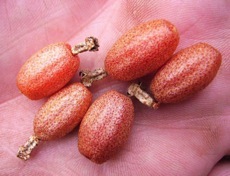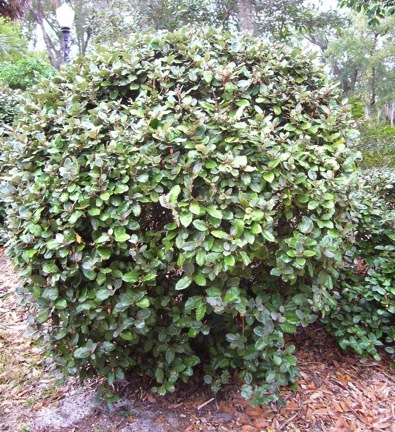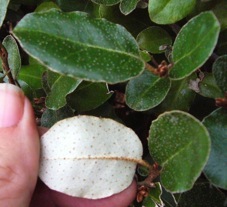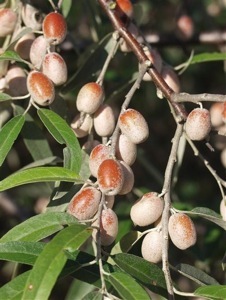Edible Elaeagnus
First it was “poisonous.” Then it was “not edible.” Later it was edible but “not worth eating.” Actually, it’s not toxic but tasty, and easy to identify. It makes one wonder how some plants get so maligned.
The Silverthorn, Elaeagnus pungens, came from China and Japan to North America some 200 years ago in the early 1800’s. It’s an ornamental landscape plant often used for hedges and barriers. The Silverthorn is also closely related to the Autumn Olive and Russian Olive, both of which have edible fruit as well (E. umbellata, E. angustifolia.)
Perhaps the bad-mouthing also comes from the fact the Silverthorn has escaped cultivation. The shrub is found from Virginia south to Florida and west to Texas. It is also found at Smith College in Northampton, Massachusetts. Florida lists it as a Category II invasive exotic species. Seems to me the only civic thing to do is eat the weeds.
Evergreen, the Silverthorn is also called the Thorny Olive and the Thorny Silverberry. It blooms
around October and has edible fruit about February. Authors’ opinions on the berry, actually a fruit, range from toxic to edible but lousy. I find them sweet and tart at the same time, and very much worth eating. But you do have to get them ripe or they can be astringent. I have also reached the conclusion that folks who write books on landscaping actually hate the plants they write about. Personally, I look forward to Silverthorn season every year. Better, it fruits in the middle of our winter. Few plants do.
From a nutritional point of view the Elaeagnus has 17 times the lycopene than tomatoes. Yes, 17 times more. The edible seed has fiber and omega 3 fatty acids but is on the bitter side. One can also eat the seed shell but I prefer not to. The plant is a nitrogen fixers which means it can grow in poor soil and provide nitrogen for other plants.
As for the common names, the bush does not really have thorns but rather sharp twigs that grow into branches. The berry-like fruit is red and silver/gold (from a distance it looks like red and silver but up close red and gold.) The botanical name is a mixed menu. Pungens (PUN-jenz) is easy. It means sharp or pointed. Reminds me of the punji sticks used in Vietnam. Elaeagnus is a bit of an amalgamation and Latinized Greek. It means “Sacred Olive.” Elaia = olive tree, agnos = sacred. Why the genus was named that is anyone’s guess.
Also edible are the fruits of the E. commutata, which is native to North America. Alaskan natives fried them in Moose fat. E. multiflora, the climbing E. philippensis, and E. latifolia are also edible, the latter often cooked and or made into a compote. Many Elaeganus in their native range elsewhere in the world have edible fruit. The seed is also edible on E. umbellata. The genus is closely related to the Sea Buckthorn. (See separate entry.)
The Elaeagnus clan was championed at one time by various official and unofficial plant groups as good for land and animal. Song birds in particular like the fruit. Turkeys, hens and bears do,too. But in recent years opinions have changed and now it is view as a competitor for native species and is on several states’ hit list. I’ve only seen it under cultivation.
Elaeagnus fruit has numerous uses. It can be eaten out of hand though they tend to be astringent if picked too early. It can easily be made into fruit leather, juice, jam and jelly. You can freeze the juice and use it in yogurt or to make a tea. The fruit can be dehydrated as well. Several species have edible seeds. I usually eat the kernel and toss away the hull.
Green Deane’s “Itemized” Plant Profile
IDENTIFICATION: Shrub 3 to 25 feet, leaves are lance-shaped, evergreen, simple or wavy edges, 2 to 4 inches long. Upper leaf surface is waxy green, often scaly. Lower leaf surface are silvery and scaly with brown dots. The leaves feel tough and grainy. Young branches on branches are thorny. The Fruit can be red to red with silver or gold glitter. The seed covering has longitudinal ridges.
TIME OF YEAR: Blossoms in fall, fruits in early spring. (The Autumn Olive fruits generally in late summer or fall.)
ENVIRONMENT: Full sun is preferred and good soil but it can grow in partial shade and poor soil
METHOD OF PREPARATION: Usually eaten out of hand. Can be made into jam, jelly, fruit leather, juice can also be used to make tea or flavor yogurt. Seed kernel is edible.







Hello, Sir!
I have been following your site and videos for years now. My question concerns Elaeagnus angustifolia. This tree grows in legion out here in Colorado. Is this tree also useful in the same ways as the ones you have listed on this page?
Best Regards,
Kevin
WHOOPS! I see that you mentioned it in parenthesis.
The first picture’s caption is “Autumn Olive” but that is what I have usually heard called “Russian Olive” which is E. angustifolia whereas the second picture is of what I call “Autumn Olive”, E. umbellata. So I would have them switched.
Also, I’m bummed because this year, the birds fully discovered my little orchard of these and got most of the fruit! They also got my E. pugens fruit just this past week, in which the 9 year old shrub produced it’s record 20 fruit, despite massive amounts of flowers and bees.
Thanks Kevin… it was one of those late-night editing things…
Also, might you know what that powdery resin is on the leaves? especially thick on the E. pungens? Sometimes it gets all over my shirt when working with the plant, you can rub it off the leaves leaving them dull green.
Yeast maybe? Like that on mature Smooth Sumac trunks and branches, can be used as a sough dough bread starter.
I’m not clear on the way to tell which is which. I live on the highest mountain in Maryland and they grow all over the hillsides. Farmers aren’t big fans because they are hard to bush hog (mow) because of their tough wood. I’ve eaten the berries, seeds and all, many times with no ill effects. I’m wondering if we have different species here as they rippen at all different times from plant to plant.
You can send a sample to the state dept of ag, and they will tell you – and tell you how to kill it. It is most likely (in my experience) the Eleagnus known as Autumn Olive, E. umbellata, I think.
Nothing like a plant that fruits abundantly, provides food and cover for wildlife, and helps restore poor or damaged soils – all on it’s own! As Gabe Brown says, ‘We want to grow the things that want to die, and kill the things that want to live.’ A bit of truth there, methinks.
This is a good write-up about Eleagnus…thanks Deane.
I have two questions that I haven’t been able to find answers to anywhere on the web:
First, what is the meaning of “umbellata”.
And second (and more importantly): What is the edibility of the leaves of Eleagnus Umbellata? I understand that few people, if any, eat the leaves…but no one has written anything about this.
I want to know what the chemical constituency is of the leaves for edibility validation…raw or cooked.
Can anyone help in this area with some credible, factual information (not just, “we don’t eat them”)?
While you’re at it…what is the chemical composion of the bark and the wood? For instance, the bark of some trees/plants are used for teas…whereas the bark of black cherry would be deadly.
If you google Umbellata and Latin you will find that it means umbrella. I know nothing about leaf edibility.
My question is can the eleagnus be air propagated or air layered to grow roots on a limb,
Yes, the Eleaegnus species respond beautifully to air layering. Graham Potter has one of the best explinations of the technique I have ever seen, on his channel on YouTube.
ok dean and team,
Olive, Cardinal Autumn – is a hybrid of the Eleagnus umbellate
are the berrys any different ?
doest the hybridization make the berrys unedible?
i hear this type is smaller do you know if it still has thorns.
thanks
Hi Dean
ive gotten 3 i recieved in a trade.
not sure which ones they are ?
i live in Louisiana, but, i havent seen them flower or fruit.
the plants came from Northern Louisiana,
i am in the South (New Orleans)
id like to know what is the best (most tasty) species/cultivar/variety
i can grow in the South ??
Have you ever considered writing a book. If you created one pocket-sized with photos, it would become a best seller. I would love to have one to take in the woods with me when I hike. Your videos are great, but I can’t access them in the woods, to identify plants when I find them. If you decide to make a book, put me down for the first five copies. I think you’re great, and you’ve taught me so much.
Thanks,
Terry Riciano
Maybe he should put together a kickstarter?
I watch the Green Dean’s videos on my phone in the woods?
Interesting…
How do you pronounce elaeagnus? I’m trying … eh-LAY-agg[slight pause on g, then]-NUS? Almost makes me want to get a banjo out.
I didn’t put it in the article? el-lee-AG-nuss (the ae is like the ae in Caesar and AG is like the Ag in agriculture.)
How do you know when the fruit is ripe? I am interested in the idea of eating the fruit but I read everywhere to be careful to eat them when they’re ripe but nobody says how to recognize when they’re ripe.
It says in this article when they are ripe. The fruit turns red and had sliver/gold speckles.
Utah
We have plenty hear, at times that are a a burden. The children
Will eat the seeds and put them in there noses quite frequently.
There is roomed spiriTualatin theory. & if they are poisonous.
Though after the read, sounds like a desert treasure.
Dear Green Deane- There is still no separate entry on your website nor a video on the autumn olive, only the mention as a relative of silverthorn, Russian olive, etc. Not sure if this shrub is scarce in Florida, but obviously it is abundant in many regions of the US. It is one of our favorite fruits, partly because it is not overly sweet, like so many popular fruits sold in grocery stores.
Eagerly awaiting the new entry!
We are also hoping you will write a book on wild and ‘feral’ edibles!
So which is the best tasting ?
i have 5 types.
I am in a forum for tropical fruit
and some of the guys there say E. Latifolia
also called “So-Shen” /or/ “So Shang” and “Bastard Oleaster”
have MUCH larger fruit.
ive seen some videos of the fruit for sale
they are the size of an egg.
so far, the So_Shen i have from seed all died except 1
i hope it makes it.
so i finally tasted one i had bought from Home Despot for $2
(elaeagnus x ebbingei)-its a hybrid called silverberry.
after only 6 months it flowered and gave me a good bit of fruit for the 3ft tree.
the fruit was delicious !
The problem was, there was very little flesh.
and the seed is wrapped in a woody case, so if you chew it, you can get a little more nutrition out of the seed (not much, and not much flavor) bu i suspect its high in proteins , fats and minerals, so i chew them.
like i said, still not much there, and you have to spit out the woody case after its chewed, but its an OK nibble while walking through the garden with some nutrition too.
I’ve eaten from my russian olive oleaster trees since late September. Jelly’s, holiday cider and squeeze lemon in with honey for great lemonade. Ad water 3 inches above the olives in pan to boil. The olives swelled and sink and flavonoids released.. blender on stir awhile warm to knock meaty off seeds, strainer on bucket to dump in. Then cheesecloth over strainer bowl on another bucket. Cheesecloth will need changed couple times because more meaty than they appear once boiled. Drink the juice or add honey cinnamon and cloves for cider. Or use for jelly recipe. Roast spend seeds darkest after air drying. Grind for delicious coffee. Enjoy. It accumulatively builds up in your system for amazing healings inside and out.
Unfortunately If there ever was an “Elaeagnus pungens” at Smith College, it’s no longer there 🙁
How do I know? I live up the street from Smith & am a volunteer at its Botanic Garden…
You failed to mention the aroma of the blossoms! It is delightful!
I love your humor and insights. Keep sharing!
It is important to me that I do no harm. When I read about how invasive my plants are, I feel guilty. Then I consider how reckless and inconsiderate it is to feed Americans toxins labeled as food. My reality check gives me conviction that it is right to grow what nourishes us.
we wish to do no harm, yet it is right to grow what nourishes us and surrounds us with beauty!
We are new to New Mexico and the Albuquerque area, and we have purchased a home. Many yards are xeriscaped with low water plants that can endure much. Altitude is 6000, we have snow/frost in the winter and blasting intense sun in the summer. Local plants are recommended by the neighborhood association, but Elaegnus was recommended to me by a local nursery person.
My biggest concern is invasiveness. I love it that it has berries, but would feel very bad if birds carried seeds to local landscape and it took over! How great is this possibility in your estimate?
I’ve eaten elaeagnus for several years now, after learning about it from Merriweather’s Foraging Texas site.
One time, a friend from Thailand saw me eating it and asked for some. She said they’re grown for food there, and that the ones I shared (from a landscaping plant) were smaller, but sweeter.
I was wondering how far south these will grow and produce fruit. My son lives in zone 7 and recently obtained a few and asked me if I wanted a couple plants. The research I did showed them growing as far south as zone 8b. I am in Okeechobee, but I live on the water, which gives me a micro climate of what I would call 9c. 11 years and no frost to date. Had a heavy frost last January across the street, but my papayas, bananas and young coconut trees weren’t phased. Because of this I passed on the silverthorn. If they will fruit here, I would love to add another nitrogen fixer to my food forest.
In Japan it is much loved by some adults in their 30s+ as a plant they used to enjoy as children, foraging around their homes for berries. They call it “gummy” here (pronounced “goomie”).
Working in the plant nursery business for many years, these were often referred to as “Ugly Agnes” (sounds like ealeagnus). Not a favorite of wholesale growers, as they get big and rangy.